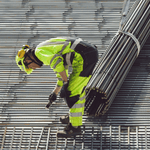Table of Contents
High-visibility (Hi-Vis) workwear is widely used in construction, transportation, logistics, and emergency rescue industries to ensure that workers can be clearly identified in low-light conditions or complex working environments. Reflective tape, as a core component of Hi-Vis workwear, plays a crucial role in visibility enhancement. The reflective performance of this tape is influenced by several key factors, which this article will explore in detail.
Quality of Reflective Materials in Hi-Vis Workwear
Reflective tape is typically made using glass beads or microprism structures, both of which enhance visibility by refracting and reflecting light. High-quality glass beads have a higher refractive index, effectively directing light back toward the source and increasing brightness. Meanwhile, microprism structures provide directional reflection, improving visibility from greater distances. The quality of these materials directly affects the brightness and durability of the reflective tape.
Cleanliness of Reflective Tape in Hi-Vis Workwear
Dirt, dust, grease, or chemical residues on the surface of reflective stripes can significantly reduce its light reflection efficiency, thereby diminishing its visibility. Regular cleaning of the tape prevents the accumulation of contaminants. Using appropriate cleaning methods ensures the reflective material remains effective and maintains its optimal performance.
Degree of Wear and Tear on Hi-Vis Workwear
Over time, reflective tape may experience degradation due to friction, folding, washing, or environmental exposure. Scratches, cracks, and fading can significantly reduce its ability to reflect light effectively. Periodic inspection of reflective stripes helps identify and replace damaged sections to ensure consistent visibility and safety.
Ambient Light Conditions and Hi-Vis Reflectivity
Reflective tape functions by reflecting external light sources, meaning the intensity and angle of incoming light affect its performance. Under bright sunlight, the visibility of reflective stripes may be less noticeable. However, in nighttime or low-light conditions, when illuminated by vehicle headlights or flashlights, the tape exhibits superior performance, ensuring that workers remain visible.
Contrast Between Reflective Tape and Background in Hi-Vis Workwear
The visibility of reflective tape varies depending on its color and the background environment. Silver and yellow reflective stripes are commonly used in Hi-Vis workwear because they provide high contrast in a variety of lighting conditions. Selecting the appropriate reflective color to maximize contrast with the work environment can significantly enhance visibility and safety.
Proper Usage and Storage to Maintain Hi-Vis Reflectivity
Incorrect washing methods, such as using strong alkaline detergents, high-temperature drying, or excessive scrubbing, can damage the reflective coating, reducing its effectiveness. To preserve the reflectivity:
- Use gentle washing and air drying.
- Store workwear in cool, dry environments to prevent premature degradation of reflective materials.
- Avoid prolonged exposure to humidity or direct sunlight, as this can weaken the tape’s adhesive and reflective properties.
Angle of Incident Light and Viewing Position in Hi-Vis Workwear
The angle at which light strikes the reflective tape and the position of the observer relative to the light source also impact its visibility. Retroreflective materials perform best when the light source and observer are aligned, such as when vehicle headlights illuminate a worker directly in the line of sight of the driver. However, visibility diminishes when viewed from sharp angles or when the tape is partially obstructed.
Exposure to Harsh Environmental Conditions and Hi-Vis Reflectivity
Reflective tape can degrade when exposed to extreme weather conditions such as prolonged UV radiation, heavy rain, and extreme temperatures. UV rays can cause discoloration and weaken the adhesive properties of the tape, reducing its reflectivity. To mitigate these effects, manufacturers often apply UV-resistant coatings to enhance durability. Ensuring that workwear is designed for specific environmental conditions can improve its longevity and performance.
Multi-Layer Construction and Durability Enhancements in Hi-Vis Workwear
Some advanced reflective stripes feature multi-layer coatings that enhance their durability and resistance to environmental factors. These tapes may include:
- Protective layers that resist abrasion and chemical exposure.
- Moisture-resistant coatings to prevent water damage.
- Flexible materials that maintain reflectivity even with repeated bending or stretching.
These enhancements ensure long-term reliability in demanding work conditions.
Conclusion
Reflective tape on Hi-Vis workwear plays a vital role in ensuring worker safety by enhancing visibility in various lighting conditions. The effectiveness of reflective materials is influenced by multiple factors, including material quality, cleanliness, wear and tear, ambient light conditions, contrast with the background, proper maintenance, angle of incident light, environmental exposure, and advanced durability features. By selecting high-quality reflective materials, adhering to proper care and storage practices, and incorporating the latest durability enhancements, employers and workers can maximize the longevity and effectiveness of Hi-Vis workwear, ultimately improving workplace safety and reducing accident risks.
In industries where safety and visibility are crucial, WERKVIS provides high-quality Hi-Vis workwear designed to enhance protection and comfort. With a European design team and offices and warehouses across Europe, WERKVIS combines advanced design with practicality to deliver reliable and durable workwear. Whether you're in construction, logistics, or any other high-risk field, WERKVIS is your trusted partner in ensuring both safety and comfort. Let's work together for a safer, more efficient future!















